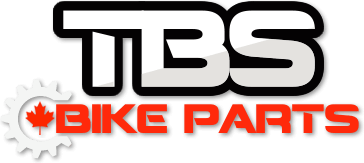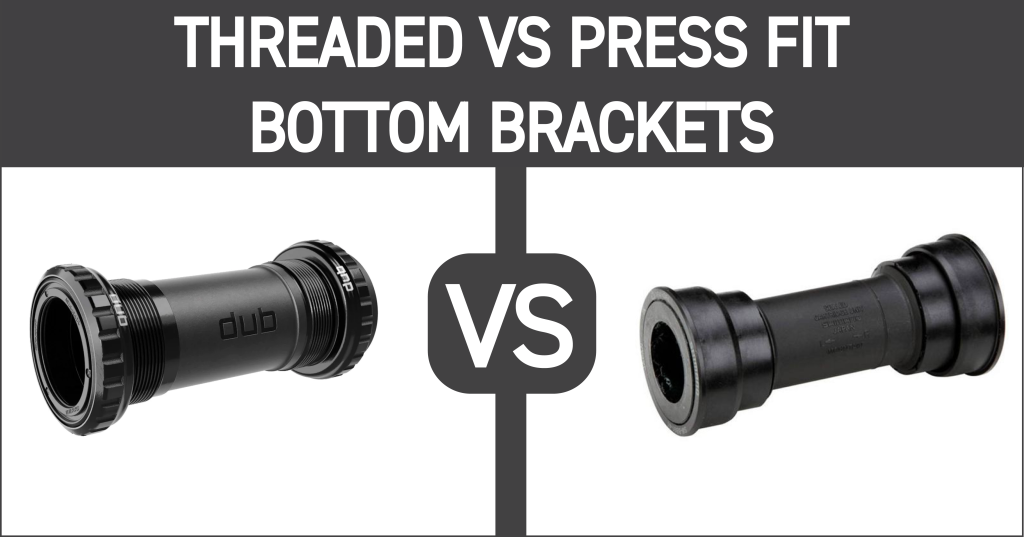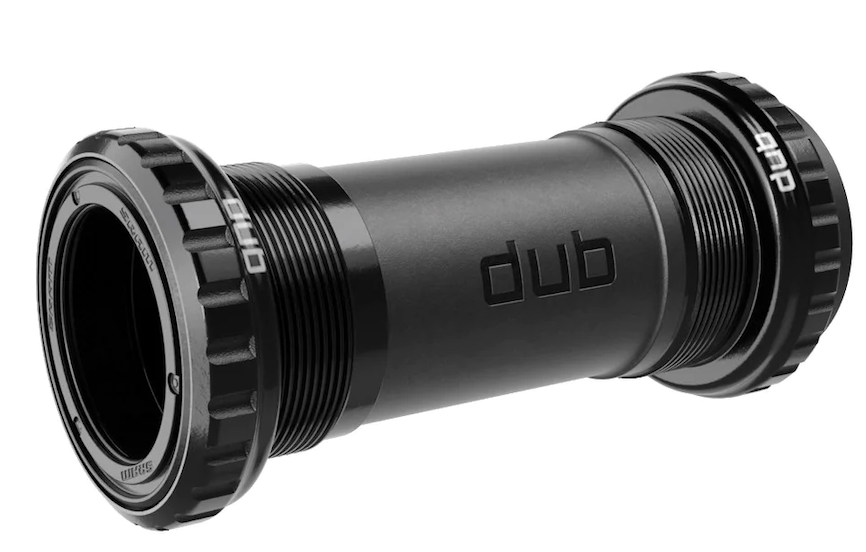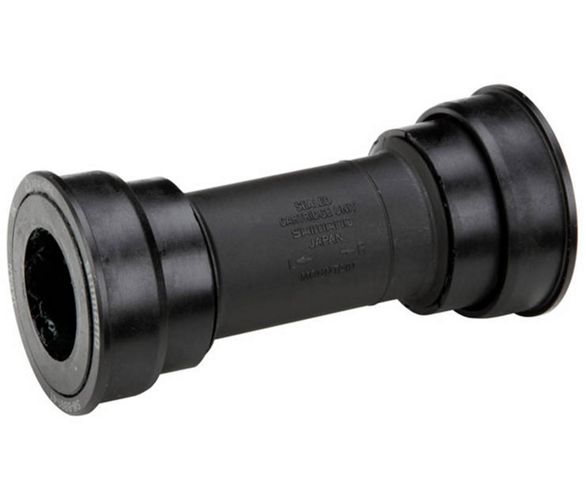Threaded vs. Press Fit Bottom Brackets
Threaded vs. Press Fit Bottom Brackets - Bottom brackets (BB) are components in bicycles that connect the crankset to the bike frame. Threaded and press-fit are two of the most common types of bottom bracket designs, and each has its advantages and disadvantages. In the following article we are going to compare threaded and press-fit bottom brackets:
Bottom Bracket (BB) Overview
Before we get into the differences between threaded and press fit bottom brackets we are going to do a quick overview of bottom brackets (BB).
A bottom bracket is a bike component that connects the crankset (the set of chainrings and cranks) to the bike frame. It provides support and allows the crankset to rotate smoothly, transmitting the rider's pedaling force to the chain and ultimately propelling the bike forward. The bottom bracket also houses the bearings that enable the crankset to spin freely. It is a critical part of the drivetrain system.

Bottom Bracket Shell: The bottom bracket shell is a part of the bicycle frame. It is the section of the frame where the bottom bracket is installed. The design of the bottom bracket shell can vary between different types of bicycles and frames.
Bearings: Bearings are crucial components within the bottom bracket that allow the crankset to rotate. There are different types of bearings, including ball bearings and cartridge bearings, and they can be housed in various configurations depending on the bottom bracket type.
Crankset Compatibility: The bottom bracket needs to be compatible with the specific type of crankset on the bike. Different cranksets have varying spindle lengths and designs, so the bottom bracket must accommodate these specifications.
Axle/Spindle: The spindle, also known as the axle, is the part of the bottom bracket that connects the left and right crank arms. The spindle passes through the bearings and is an integral part of the crankset. The design and diameter of the spindle can vary between bottom bracket standards.
Threaded Bottom Bracket
A threaded bottom bracket is a type of bottom bracket system used in mountain bikes. It consists of a set of threads on the inside of the bottom bracket shell of the bicycle frame and corresponding threads on the outside of the bottom bracket itself. This design allows the bottom bracket to be threaded into the frame, securing it in place. Threaded bottom brackets are commonly found on a variety of bicycles, including road bikes, mountain bikes, and some hybrid bikes.
Here are some key features and characteristics of threaded bottom brackets:
Installation:
The installation of a threaded bottom bracket involves screwing it into the threaded bottom bracket shell on the bicycle frame. A special tool, typically called a bottom bracket tool, is used to tighten the bottom bracket securely.
Compatibility:
Threaded bottom brackets come in different standards, depending on the frame's specifications. Common threaded standards include BSA (British), Italian, and a few others. The choice of standard depends on the frame design and manufacturer specifications.
Ease of Maintenance:
Threaded bottom brackets are generally considered easier to install and remove compared to some press-fit designs. This ease of maintenance can be advantageous for cyclists who perform their own bike maintenance.
Creaking Concerns:
Threaded bottom brackets are often less prone to creaking issues compared to some press-fit designs. The threaded interface tends to provide a secure and stable connection, reducing the likelihood of unwanted noises.
Durability:
The threaded design can contribute to the durability and reliability of the bottom bracket. It is a well-established and proven system in the cycling industry.
Common Standards:
The most widely used threaded standard is BSA (British Standard) with a 1.37" x 24 TPI (threads per inch) threading. Italian threading is another standard, but it is less common.
When choosing or replacing a threaded bottom bracket, it's crucial to match the bottom bracket type and standard with the specifications of the bicycle frame and crankset. Proper installation and regular maintenance will help ensure smooth operation and longevity of the bottom bracket.
Press Fit Bottom Bracket
A press-fit bottom bracket is an alternative type of bottom bracket system used in bicycles. Unlike threaded bottom brackets, press-fit bottom brackets do not have threads on the inside of the bottom bracket shell in the frame. Instead, the bearings are pressed directly into the frame, creating a snug fit. This design eliminates the need for threaded interfaces and allows for larger diameter bearings, potentially enhancing stiffness and reducing weight.
Here are some key features and characteristics of press-fit bottom brackets:
Installation:
Press-fit bottom brackets require precision during installation. The bearings are pressed directly into the bottom bracket shell of the frame using specific tools. This process requires careful alignment to ensure a proper fit.
Compatibility:
Press-fit bottom brackets come in various standards, including BB30, PF30, BB86, BB92, and others. Each standard has specific dimensions, and compatibility depends on the frame's specifications and design. It's crucial to use the correct press-fit standard for a particular frame.
Larger Bearings:
Press-fit systems often allow for larger diameter bearings compared to threaded systems. Larger bearings can potentially improve stiffness and durability.
Weight Savings:
Press-fit designs can be lighter than threaded counterparts because they eliminate the need for metal threading in the frame's bottom bracket shell.
Design Flexibility:
Press-fit systems provide frame manufacturers with more design flexibility. They can optimize the frame for larger bearings and experiment with various frame shapes without being constrained by threaded interfaces.
Potential Creaking:
Press-fit bottom brackets are also associated with creaking issues. The absence of threads can result in a less secure fit, and dirt or debris accumulation may contribute to creaking sounds. Proper installation, appropriate frame tolerances, and regular maintenance are crucial to mitigate these issues.
Standards:
Common press-fit standards include BB30, PF30, BB86, BB92, BBright, and others. Each standard has specific dimensions, and compatibility is essential for proper function.
When choosing or replacing a press-fit bottom bracket, it's vital to match the bottom bracket type and standard with the specifications of the bicycle frame and crankset. Due to the precision required for installation, some cyclists may prefer professional assistance when working with press-fit bottom brackets. Regular maintenance and attention to proper tolerances can help prevent creaking and ensure optimal performance.
Compatibility Examples
The compatibility between bottom brackets and cranksets is crucial for proper functioning and efficient power transfer in a bicycle's drivetrain. Here are some examples of bottom bracket and crankset compatibility based on common standards:
Threaded Bottom Bracket (e.g., BSA) with External Bearing Crankset:
Example Bottom Bracket: BSA (English) threaded bottom bracket with 1.37" x 24 TPI threading.
Compatible Crankset: Shimano Hollowtech II, SRAM GXP (external bearing) cranksets.
Threaded Bottom Bracket (e.g., Italian) with Square Taper Crankset:
Example Bottom Bracket: Italian threaded bottom bracket.
Compatible Crankset: Older square taper cranksets from brands like Campagnolo or vintage bicycles.
Press-Fit Bottom Bracket (e.g., BB30) with BB30 Crankset:
Example Bottom Bracket: BB30 press-fit bottom bracket.
Compatible Crankset: Cranksets designed for BB30 bottom brackets, such as certain models from SRAM and Cannondale.
Press-Fit Bottom Bracket (e.g., PF30) with PF30 Crankset:
Example Bottom Bracket: PF30 press-fit bottom bracket.
Compatible Crankset: Cranksets designed for PF30 bottom brackets, such as certain models from SRAM and FSA.
Press-Fit Bottom Bracket (e.g., BB86) with Shimano Hollowtech II Crankset:
Example Bottom Bracket: BB86 press-fit bottom bracket.
Compatible Crankset: Shimano Hollowtech II cranksets designed for press-fit systems.
Press-Fit Bottom Bracket (e.g., BB92) with SRAM DUB Crankset:
Example Bottom Bracket: BB92 press-fit bottom bracket.
Compatible Crankset: SRAM DUB cranksets designed for press-fit systems.
It's important to note that these are just examples, and the specific compatibility can vary based on the manufacturer's specifications and the model year of the components. Always refer to the manufacturer's documentation for your specific bottom bracket and crankset to ensure compatibility.
Our Take
In summary, both threaded and press-fit bottom brackets have their pros and cons. The choice between them may depend on factors like personal preference, ease of maintenance, frame compatibility, and the specific requirements of the bike. Each type has its advocates, and the ongoing evolution of bike technology may influence preferences in the cycling community over time.
If you are in need of a bottom bracket you can shop our full selection here. We also stock a variety of cranksets that can be purchased here. We offer free shipping on all orders over $149CAD. All orders are processed and shipped within 24 business hours.
Spend less and ride the best with TBS Bike Parts.
Related Articles
SRAM “FULL MOUNT” HANGERLESS DERAILLEUR SYSTEM
WHAT IS AN XD (XD DRIVER) FREEHUB?
SRAM’S UNIVERSAL DERAILLEUR HANGER OVERVIEW
WHAT IS A MICROSPLINE FREEHUB?
SHIMANO HYPERGLIDE+ VS. LINKGLIDE
5 REASONS YOU SHOULD UPGRADE TO WIRELESS SHIFTING FOR YOUR MTB




